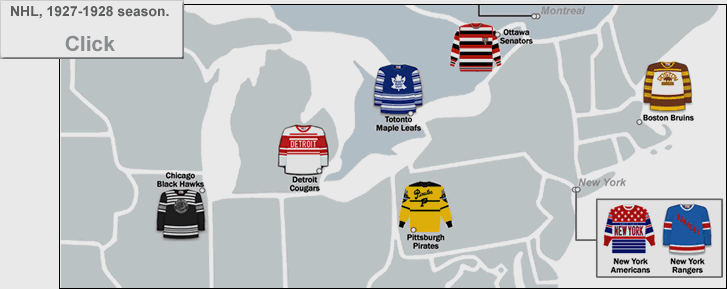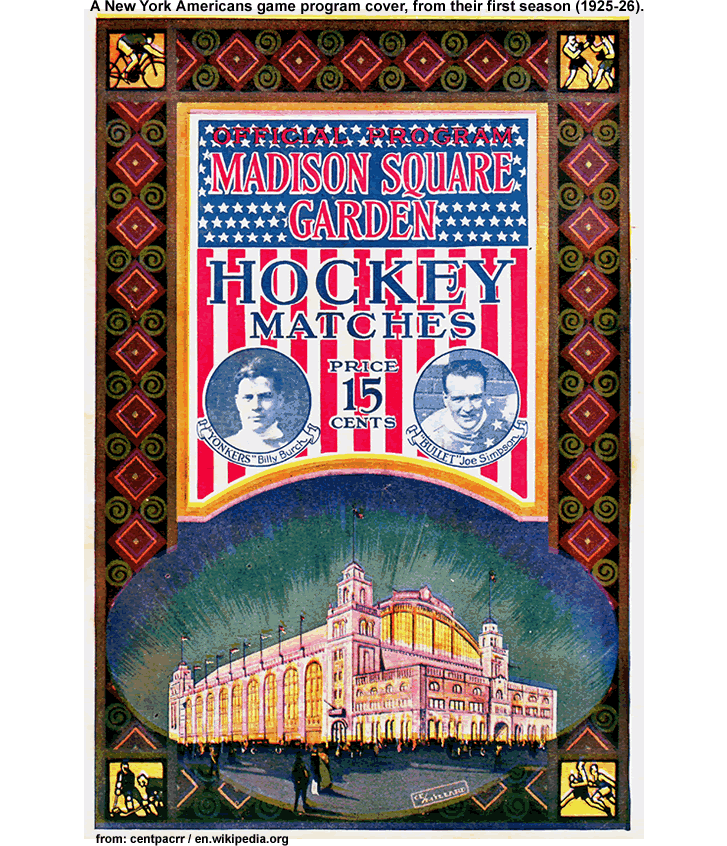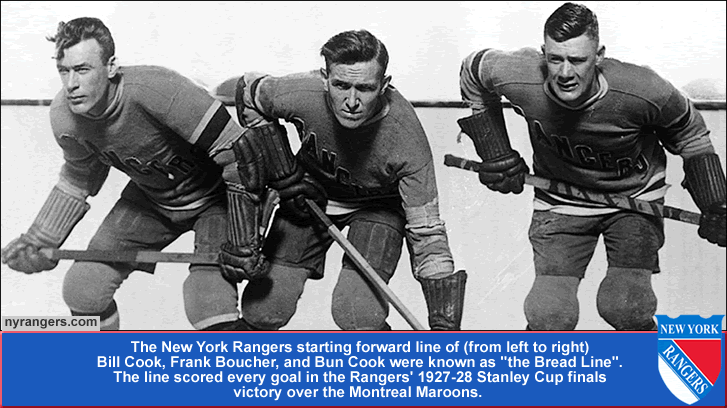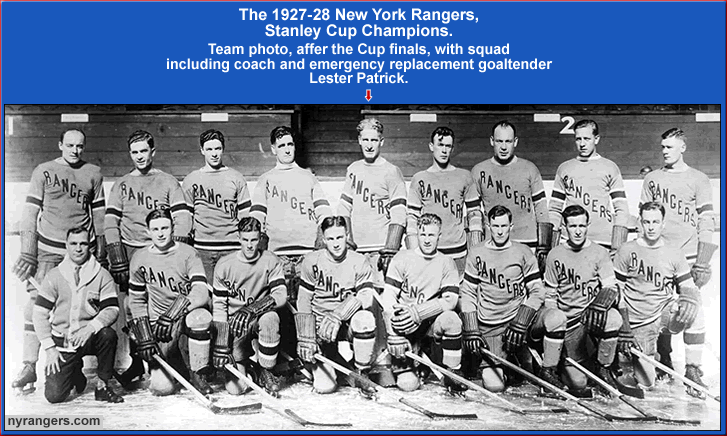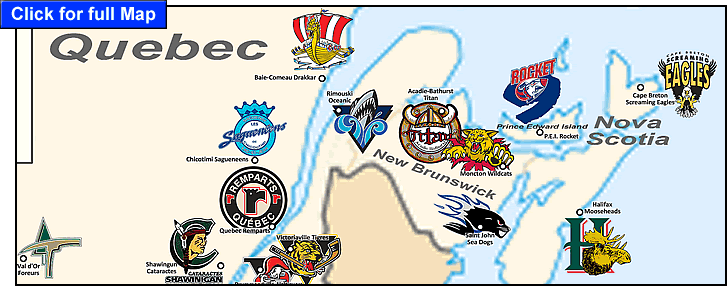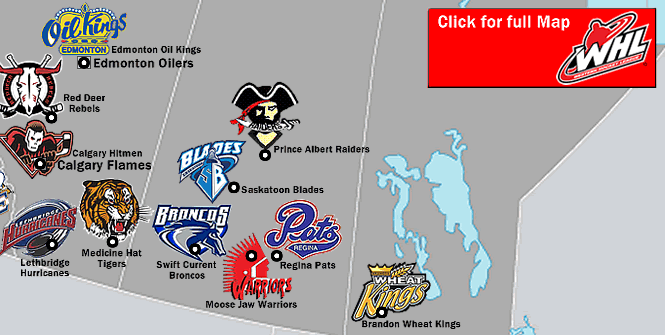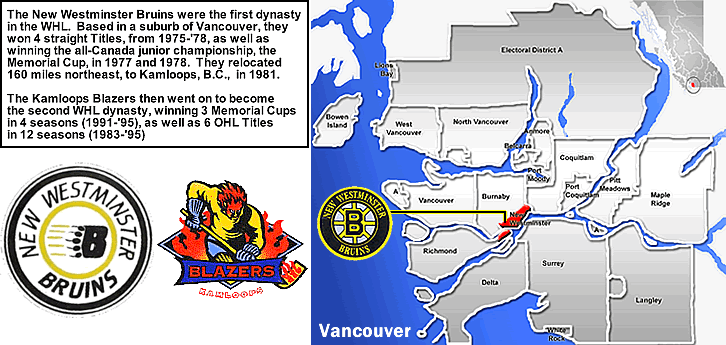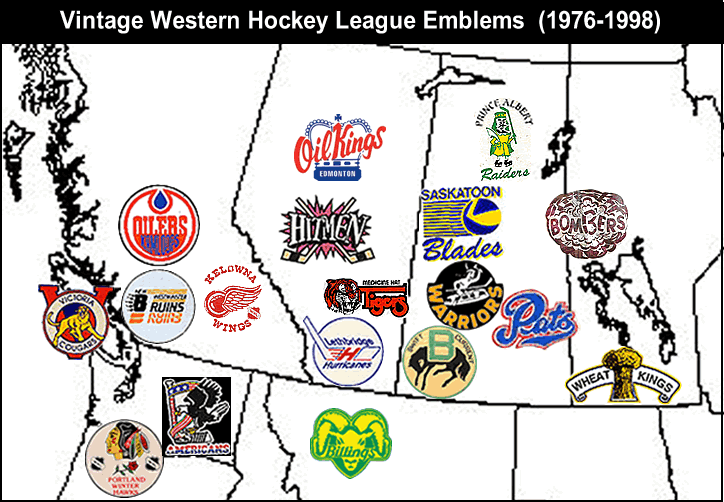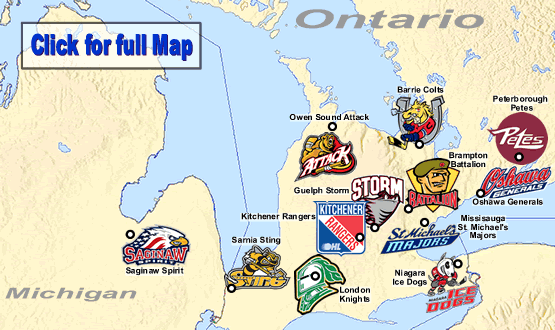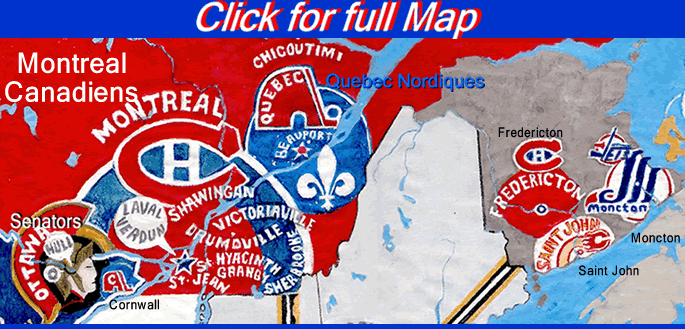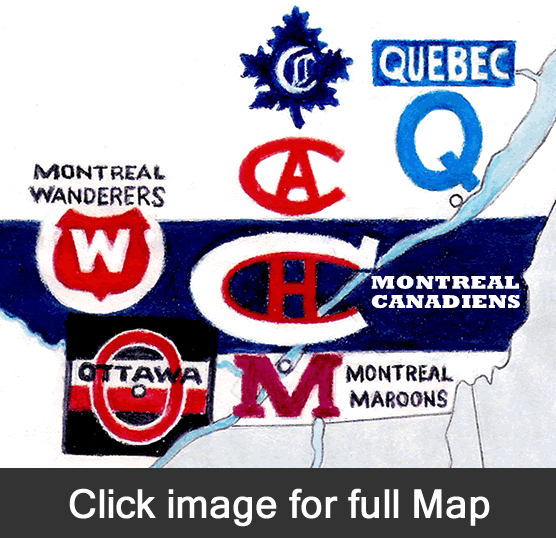…
This map shows the teams in the 1927-1928 National Hockey League season. It was the NHL’s eleventh season. Reigning champions (ie, Stanley Cup Holders) were the Ottawa Senators.
In 1927-28, there were 10 teams in the NHL. The league was divided into Canadian and American Divisions during this era. This divisional split was not along strictly national lines, as the New York Americans were in the Canadian Division. The names of the divisions became even more misleading later, in 1934-35, when Ottawa moved to St. Louis but still played in the Canadian Division. The two division set-up ended after the 1937-38 season, when the Montreal Maroons folded. [The NHL then reverted to a one-division league for 29 seasons until the1967-68 season, when it doubled in size from 6 to 12 teams.]
By 1938 when the Maroons ceased operations, the Great Depression had also claimed two other NHL franchises, the Pittsburgh Pirates/Philadelphia Quakers in 1931, and the Ottawa Senators/St. Louis Eagles in 1935. Both these hockey clubs made a last-ditch effort to save the team by moving to a different city for what turned out to be their final season.
Ottawa was by far the smallest market in the league, and problems were already evident in the 1927-28 season that is being shown here. The league had probably expanded too soon, going from 4 to 10 teams in a space of just four seasons. In the 1922-23 season, there were only 4 teams in the NHL…the Ottawa Senators, the Montreal Canadiens, the Toronto St. Patricks, and the Hamilton Tigers. Four years later (1926-27), the NHL’s size had more than doubled, to 10 teams.
In 1924-25, two teams joined the NHL, making the NHL a 6-team league…
The Boston Bruins were the first American team to join the NHL. They entered the league for the 1924-25 season, along with the Montreal Maroons, as the NHL’s first two expansion teams. The Bruins were owned by Boston grocery tycoon Charles Adams. His chain of stores had brown and gold colored signage, and this color scheme was applied to the new hockey team. [The Bruins switched from brown and gold to black and gold starting in 1934-35.] The Boston Bruins of the late 1920s were centered around star Defenseman Ernie Shore (elected to the Hockey Hall of Fame in 1947), the top player at his position in the league then. The Bruins entered the 1927-28 season as the previous season’s Stanley Cup finals losers, when they fell to the Ottawa Senators in the best-of-5 game series 2-0-2 (2 Ottawa wins, 2 tie games with no OT). The Boston Bruins would win their first Stanley Cup title in 1928-29, their second Cup title a decade later in 1938-39, their third title in 1940-41, and their fourth in 1969-70. The Bruins have not won a Stanley Cup title since their fifth championship, in 1971-72 [note: Boston won a 6th Stanley Cup title in 2010-11].
The Montreal Maroons effectively filled the gap left by the Montreal Wanderers, who won 5 Stanley Cups between 1906 and 1910, and were a founding member of the NHL. The Wanderers went under after their arena burned down, in January 1918. The Wanderers had been the hockey team of the English-speaking population of Montreal; while the Montreal Canadiens (as per the French spelling of their nickname) had a fan base that was primarily francophone. So the Maroons became the new team of the anglophone neighborhoods in Montreal. The franchise existed for 14 seasons (1924 to 1938) and won two Stanley Cup titles, their first in their second season, 1925-26, their second Cup in 1935. The Maroons drew sparse crowds, however, and by the height of the Depression circa 1938, they were looking for a new home. The franchise almost moved to Philadelphia, but there was no suitable arena in place there, and the Maroons never played again after the 1937-38 season ended.
In 1925-26, two more teams joined the NHL as expansion franchises, and one franchise was dropped, making the NHL a 7-team league…
The Pittsburgh Yellow Jackets were a successful two-time winner of the US Amateur Hockey Association. In 1925, the hockey club was sold and changed its name to the Pittsburgh Pirates, with the nickname allowed by the Pittsburgh Pirates baseball club. That same year, the hockey club was granted a franchise in the NHL. The team was originally built around a football scholarship athlete at Duquesne University named Lionel Conacher, who was from Toronto. Connacher recruited top amateurs from Toronto and Ottawa to come play for Pittsburgh. In 1925-26, the Pittsburgh Pirates player/coach Odie Cleghorn, a notorious bruiser of a player, was the first to use the innovation of set lines and line rotation. The franchise existed for five seasons in Pittsburgh, and played its final season (1930-31) at the other end of the state of Pennsylvania, as the Philadelphia Quakers. The Pirates made the playoffs twice, their last time in 1927-28, losing to Montreal in round one. In 1931, the team became the first of 4 NHL teams to go out of business in the Depression era.
The New York Americans were the first NHL team to play in New York, preceding the New York Rangers by one year. Bootlegger “Big Bill” Dwyer was the first owner of the team. The franchise was in the right place at the right time in gaining the collective rights to the Hamilton Tigers roster, following league suspension of the Hamilton franchise in early 1925 in the wake of a player strike for unpaid playoff wages. [The Hamilton Tigers existed for six seasons in the NHL from 1920 to 1925; their roots being in Quebec City, Quebec, where from 1878 to 1920 they were the two-time (1912, 1913) Stanley Cup winning hockey club called the Quebec Bulldogs. The Quebec Bulldogs were invited to be a founding member of the NHL in 1917, but were forced to suspend operations for two years for lack of funds. Quebec joined the NHL for the 1919-20 season, changing its name to the Quebec Athletic Club. Quebec played one season in the NHL, finishing in last place. The league took back the insolvent franchise, and to head off the potential start-up of a rival league in Hamilton, Ontario, the NHL placed the club there, as the Hamilton Tigers.]
Below is a striking game program cover for the New York Americans first season, featuring an illustration of the third Madison Square Garden, which was on 50th St. and Eighth Avenue in the Broadway district of Manhattan, New York City, NY. This incarnation of Madision Square Garden existed from 1925 to 1968, and was supplanted by the fourth and current incarnation of “the Garden” (where the New York Rangers still play), which is about a mile and a half south, at 32nd St. and Broadway. Note: click on image below to get a centered view.
The illegality of their owner Bill Dwyer’s bootlegging fortune notwithstanding, the New York Americans were a team that was dealt a harsh hand. That is because of a broken promise by future New York Rangers owner and Madison Square Garden (III) owner Tex Rickard, who had promised Dwyer that he could rent the Garden for New York Americans games and that Rickard himself would not go after a pro hockey team of his own. Which he did one year later, hence the era of dual pro hockey clubs in Manhattan, which lasted from 1926-27, when “Tex’s Rangers” joined the NHL, to 1942, when the then-named Brooklyn Americans (who still played in Manhattan) went bust. Furthermore, the New York Americans were hamstrung by the league placing them in the Canadian Division, thus diluting their natural rivalry with the New York Rangers.
The New York Americans (counting their one [final] season as the Brooklyn Americans) never won a Stanley Cup title in the franchise’s 17 seasons in the NHL.
In 1926-27, another round of expansion took place, this time with 3 teams being added, to make the NHL a 10-team league.
Two of the teams that entered the league in 1926-27 were comprised almost exclusively of players who came over from two teams in the rival Western Hockey League (I), which folded in early 1926. Basically, all the players on the roster of the Victoria Cougars (from Victoria, British Columbia, Canada) became members of the new Detroit Cougars NHL franchise. And the entire roster of the WHL team the Portland Rosebuds (from Oregon, USA) was transferred to the new Chicago Black Hawks NHL franchise. This negotiating feat was engineered by the Patrick brothers, Frank and Lester, who were the founders and driving force of, and players in, the Pacific Coast Hockey Association (1912-1924), and who in 1926 owned the franchise rights to two teams in the Western Hockey League (I) (1925-26), which was the re-named Western Canada Hockey League (1921-25) following the Regina Caps to Portland Rosebuds franchise move.
From 1912 to 1926, the PCHA and the WCHL produced three Stanley Cup champions…the Vancouver Millionaires (PCHA: 1915 Stanley Cup title), the Seattle Metropolitans (PCHA, 1917 Stanley Cup title), and the Victoria Cougars (WCHL, 1924-1925 Stanley Cup title). {See this post I made in December, 2008, which covers the PCHA /WCHL/WHL (I), and includes team uniforms and logos, and photos of the Patrick brothers}. The NHL does not recognize the links between the Victoria Cougars team and the Detroit franchise, or the Portland Rosebuds team and the Chicago franchise, but the people who were running the team in Michigan sure did, seeing as how the “new” Detroit Cougars kept the nickname of the Victoria Cougars. The Detroit Cougars were forced to play their first season’s home games across the Detroit River, in Windsor, Ontario, Canada. For the 1927-28 season, the Detroit Cougars moved into the new Detroit Olympia, where the franchise would play in until 1979. The Detroit Cougars changed their name to the Detroit Falcons for the 1930-31 season, and kept this name for two seasons. The Detroit Falcons were bought by grain merchant James Norris, and one of his first acts was to change the nickname and iconography of the team. Norris had spent some of his earlier years as a player on the Montreal Hockey Club, a storied amateur hockey club who were the first hockey club to be awarded the Stanley Cup (in March, 1893, no challengers), and first club to defeat a challenger for the Stanley Cup (March, 1894, 3-1 over Ottawa HC). The Montreal Hockey Club’s roots were as a cycling club, and they were often referred to as the Winged Wheelers, for their crest {see this: Stanley Cup/Challenge Cup era, from en.wikipedia.org. The winged wheel crest is visible in the accompanying photo of the 1893 Montreal Hockey Club squad.}. Detroit’s new nickname, the Red Wings, and the team’s winged wheel logo were tributes to the pioneering Winged Wheelers of Montreal. Of course, with a reference to Detroit’s then-growing automobile industry, the winged wheel was changed from a bicycle wheel to a wheel of a car. The Detroit Red Wings won their first Stanley Cup title in the franchise’s ninth season, in 1935-36, and have won 11 Stanley Cup titles overall (their last in 2007-08), making them the most successful American hockey team, and third-most successful NHL team.
The other franchise which drew most of their original roster from a WCHL team, the Chicgao Black Hawks, have not had such an illustrious history, but have become a dominant force in the 21st century NHL. Their first owner, Frederic McLaughlin, had been a commander with the 333rd Machine Gun Battalion during the Great War (now called World War I). This battalion was nicknamed the Blackhawk division, after the legendary leader of the Sauk Native American tribe, Chief Black Hawk. The Chicago Black Hawks won their first Stanley Cup title in the 1933-34 season, and their second Cup title four years later, in 1937-38. But the team has only won one Stanley Cup title since then, in 1960-61. [Note: the Chicago Blackhawks have won their 4th, 5th, and 6th Stanley Cup titles since this post was made, in 2009-10, in 2012-13, and in 2015-16.]. The organization deserves credit, though, for promoting the cause of American-born players, and the Black Hawks fielded the first ever all-American lineup in the waning days of the 1936-37 season. This was after the team was out of contention for the playoffs, so publicity stunt is one phrase that could be applied here. Nevertheless, one of these American players, Goaltender Mike Karakis, was instrumental in the Chicago Black Hawks second Stanley Cup title, won the following season. [Note: the franchise was called the Chicago Black Hawks until 1985. The nickname was streamlined to one word - Blackhawks - in 1986.].
The New York Rangers were the result of boxing promoter/sporting impresario Ted Rickard’s desire to get a hockey franchise of his own once he saw the popularity of the New York Americans, who played at the Madison Square Gardens that Rickard built and ran. There was no official nickname initially for the franchise, when New York City newspapers started referring to the new team as “Tex’s Rangers”, a play on the name of the legendary vigilante/police horsemen from nineteenth century Texas (and not a reference not to the Glasgow Rangers Football Club, even despite similar color schemes of royal blue and red). In just their second season, with PCHA co-founder Lester Patrick as coach, the New York Rangers won the Stanley Cup 3 games to 2 over the Montreal Maroons (which will be touched on later). The New York Rangers went on to win their second Stanley Cup title in 1932-33, and their third Cup title in 1939-40. But it took 54 years for the Rangers to win another Stanley Cup title, their fourth, when they were champions in 1994.
…
Problems in Ottawa…
By the 1927-28 season, it became apparent that the Ottawa Senators had a big problem on their hands, namely a xenophobic fan base that refused to turn up for home games versus American-based NHL teams. The expansion teams were also forcing an escalation in salaries. Ottawa requested a larger gate share from road games. They were also forced to sell players to make ends meet. Ottawa were reigning champions but would never hoist the Stanley Cup again, and their decline was already under way. Ottawa only had around 110,000 residents during this era (1931 census), and their small-market status would eventually doom them. In the 1927-28 season, the club tried playing a couple home games in Detroit, and the fact that they actually made a profit induced them to repeat the 2-home-games-in-Detroit the next year,and by 1929-30 Ottawa was playing 2 home games in Detroit, one home game in Boston, and 2 home games in Atlantic City, New Jersey versus each of the New York teams. The onset of the Depression, circa 1930, made matters worse, and Ottawa was granted a 1-season hiatus for 1931-32. No change in fortune greeted their return to the league for 1932-33, and after two straight last place finishes, the Ottawa Senators moved to St. Louis, Missouri, as the St. Louis Eagles, after the logo of the Anheuser-Busch brewery. Geography probably had a big hand in ruining the St. Louis Eagles’ chances at viability. The team drew well in St. Louis, but the long train rides to cities like Boston, Toronto, and Montreal had a negative effect on the squad. And their natural rivalry with the relatively nearby Chicago Black Hawks was dampened by the Eagles’ place in the Canadian Division. The St. Louis Eagles finished dead last and folded in early 1935 after their lone season in the NHL.
…
1927-28 NHL season…
There were some changes to the rules that were enacted for the 1927-28 NHL season. A new rule allowed “only the captain of a team to address the referee or judge of play during the progress of a match”. The salary caps of $35,000 total per team that were put in place for 1925-26 were lifted. To keep travel costs down, each team was allowed only a 12-man roster (which is staggering, considering the amount of injuries that hockey games produce).
The general style of play of the NHL in the late mid to late 1920s can be described as very defense-oriented. The rules that allowed for more offensive freedom and more scoring (such as forward passing in the offensive zone) would not come about for two more seasons, and it is no coincidence that some goaltending records were set in 1927-28 still stand today.
In 1927-28, Montreal Canadiens Centre Howie Morenz (who was inducted into the Hockey Hall of Fame in 1945) was the NHL’s top drawing card, and he led the league in goals and assists. Ottawa Goaltender Alex Connell (Hall of Fame, 1958) set an all-time record with six consecutive shutouts (460 minutes and 59 seconds without being scored upon). The recently re-christened Toronto Maple Leafs faced injury problems and missed out on the playoffs.
The Boston Bruins won the American Division over the Rangers by 4 points, earning a bye into round 2 of the playoffs. The Bruins were led by the top Defenseman of the era, Eddie Shore (Hall of Fame, 1947), and Goaltender Hal Winkler, who tied with Ottawa’s Connell with 15 shutouts.
The Montreal Canadiens also earned a bye into round 2 of the playoffs by winning the Canadian Division, 5 points ahead of the Montreal Maroons, but the Canadiens had faltered after hard-checking goal-scorer Pit Lepine was injured late in the regular season, and then lost in round 2 of the playoffs to the Montreal Maroons. The other division winner, Boston, also fell in round two, to the New York Rangers.
1927-28 Stanley Cup finals: Montreal Maroons vs. New York Rangers…
[Note: The Stanley Cup finals were a best-of-five games series then. The Stanley Cup finals became a best-of-7 games series starting in 1938-39.]
The Rangers were led by captain and Right Winger Bill Cook (Hall of Fame, inducted 1952), who had 18 regular season goals, and Center Frank Boucher (Hall of Fame, 1958), who netted 23 times in the 1927-28 regular season (fourth highest). With Bill Cook’s brother Left Winger Frederick “Bun” Cook (Hall of Fame, 1995), the three formed the Rangers’ ”Bread Line”.
The Montreal Maroons were powered by Forward Nels “Old Poison” Stewart (Hall of Fame, 1962), and Defenseman/Forward Babe Siebert (Hall of Fame, 1964).
The annual visit of the Ringling Brothers and Barnum & Bailey circus to Madison Square Garden forced all games to be played at the Montreal Forum. The circus was the Garden’s big money maker back then, so the Rangers were forced to play the entire series on enemy ice.
The Montreal Maroons won the first game 2-0. In the second game, with the game at 0-0, Rangers Goalie Lorne Chabot had to leave the ice due to an eye injury, when Nels Stewart fired a shot that struck Chabot above the left eye. The Rangers had no replacement in goal, and though the Ottawa Senators goalie Alex Connell was in the crowd there that night, the Maroons would not allow him to come into the game as the Rangers’ replacement. So one of the most famous incidents in hockey history then occurred, when 44-year old Rangers coach Lester Patrick, a Defenseman in his day, donned the pads and stepped in as the replacement goaltender. Saying “Boys, don’t let the old man down,” Patrick inspired the Rangers to a 2-1 overtime win to even the series. Patrick did let in one goal in the third period that evened the score at 1-1, but not before he made two spectacular saves. In the overtime period, “Gentleman” Frank Boucher stole the puck and scored the winning goal. {See this, on the event, from Lester Patrick’s Wikipedia entry. Note, the photo there is a doctored image, and there is no known photo of Les Patrick’s historic goaltending stint.} To this day, Lester Patrick is the oldest player to play in a Stanley Cup finals.
For the subsequent games, the Rangers hired New York Americans goaltender Joe Miller, who posted a 1-0 shutout in the fourth game, after the Maroons had won the third game 2-0. The Rangers won the fifth game 2-1, on a Frank Boucher goal that was set up by a pass from Defenseman “Ching” Johnson (Hall of Fame, 1958). The New York Rangers even were able to celebrate with some of their fans, as a contingent of Rangers supporters had made the trek up to Montreal.
In winning the 1927-28 Stanley Cup, the New York Rangers became the second American team to win a Stanley Cup title, and the first NHL team from the USA to win the Stanley Cup title [the Seattle Metropolitans of the PCHA were the first American team to win a Stanley Cup title, in 1917, when they defeated the Montreal Canadiens of the NHA, 3 games to 1].
Below is a photo of the 1927-28 Stanley Cup champions, the New York Rangers, with Lester Patrick top row, center {to see all the names of the players, click here (New York Rangers official site)}.
Lester Patrick coached the New York Rangers for 12 more seasons, leading the Rangers to another Stanley Cup title in 1932-33, before moving to the front office in 1939, where he was the team’s general manager until 1946. He was inducted into the Hockey Hall of Fame in 1947.
Thanks to Jersey Database.com , for jerseys {click here (set at Hockey)}. The Jersey Database site has been re-designed and it is great fun to scroll through the old jerseys of each NHL team.
Thanks to the venerable http://www.nhluniforms.com , which has also benefited from a nice re-design. The jerseys of the defunct NHL teams on the map are from this site.
Thanks to the contributors to the pages at en.wikipedia.org {click here (set at list of defunct NHL teams)}. Thanks to the New York Rangers site {click here (set at Tradition/The Birth of the Rangers)}. Thanks to Chicago Blackhawks site {click here (set at History/The McLaughlin years)}. Thanks to http://www.hockeydb.com , for statistics. Thanks to Pittsburgh Hockey.net {click here (set at Pittsburgh Pirates (NHL) Jersey History)}.
Thanks to “The Official National Hockey League 75th Anniversary Commemorative Book”, edited by Dan Diamond, published by McClelland and Stewart, Inc., Toronto, 1991; 1994 edition. {at Amazon.com, here}.
